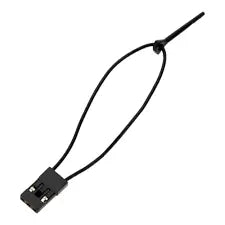The binding key on a drone's radio receiver is a crucial component for establishing a secure connection between the receiver and the transmitter (remote control). This key is used during the binding process, where the receiver and transmitter synchronize with each other to ensure they communicate properly.
To bind the receiver, you typically press the binding key while powering on the receiver. This action puts the receiver into binding mode, allowing it to search for and connect with the transmitter. Once the binding process is complete, the receiver will be able to receive signals from the transmitter, enabling control of the drone. This process ensures that the receiver only responds to the signals from your specific transmitter, enhancing security and reducing interference from other radio signals.
Package Include:
1× Binding Key
| Specification | Description |
| Binding Key | Details |
| Frequency Range | 2.4 GHz (commonly used frequency for RC transmitters and receivers) |
| Modulation | Frequency-Hopping Spread Spectrum (FHSS), Direct Sequence Spread Spectrum (DSSS) |
| Protocols | DSMX, DSM2, FrSky ACCST, Futaba FASST, etc. |
| Power Source | Usually powered by the receiver or an external battery (e.g., 3.7V Li-Po) |
| Connectors | USB, UART, or proprietary connectors (depends on the transmitter model) |
| Compatibility | Must be compatible with the transmitter and receiver model |
| Binding Procedure | Steps to bind the transmitter to the receiver, often involving pressing a button or following specific steps in the transmitter’s menu |
| Indication | LED indicators or audio signals to show binding status |
| Range | Typically up to 1-2 km for standard systems, higher for long-range systems |
| Safety Features | Fail-safe settings to ensure the drone returns to a safe state if connection is lost |
| Firmware Updates | Possible via USB or wirelessly, depending on the transmitter and receiver |
| Dimensions | Size specifications for the binding key if it is an external module |






